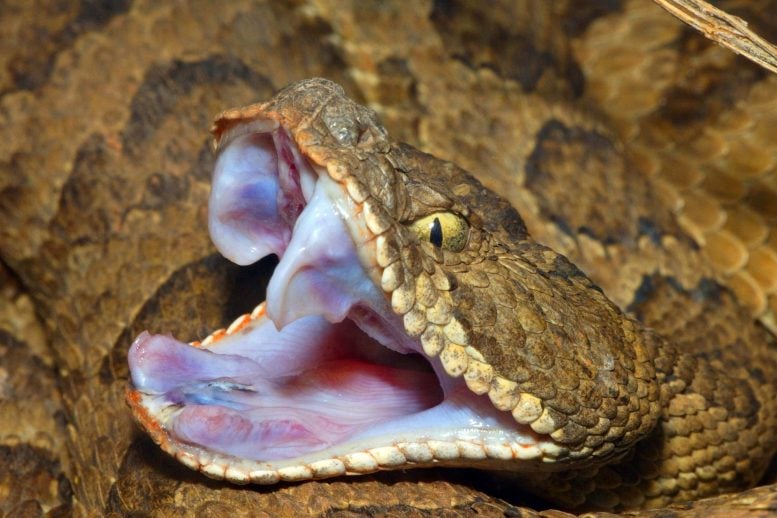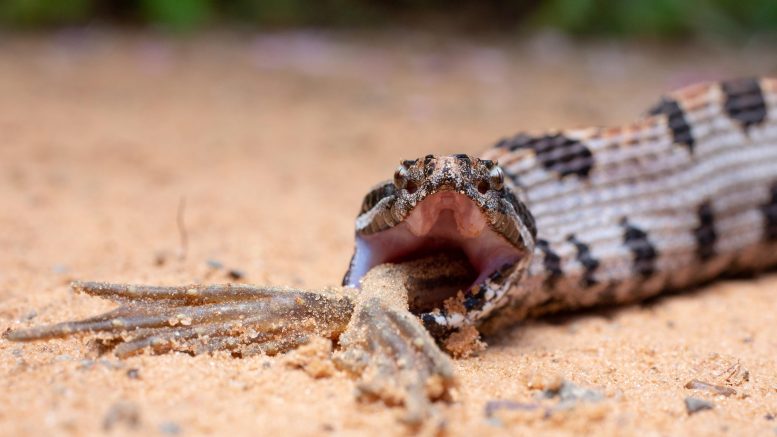
Diversity in diet plays a role in the complexity of venom in pit vipers such as rattlesnakes, copperheads and cottonmouths.
But new collaborative research by Clemson University scientists found the number of prey species a snake ate did not drive venom complexity. Rather, it was how far apart the prey species were from each other evolutionarily.
“It’s not just diet that drives the variation in venom across snakes. It’s the breadth of diet,” said Christopher Parkinson, a professor in the College of Science’s Department of Biological Sciences. “If a snake eats 20 different species of mammals, its venom will not be very complex. But if it eats a centipede, a frog, a bird and a mammal, it’s going to have a highly complex venom because each component of that venom is affecting something different in one of the different animals the snake is feeding upon.”
The journal Proceedings of the National Academy of Sciences published the findings in a paper titled “Phylogenetically diverse diets favor more complex venoms in North American pit vipers.”
The research could lead to better anti-venoms and serve as a dietary database for other snake researchers.

“Snakebite is a neglected tropical disease. It doesn’t kill many people in the U.S., only around eight per year. But it causes lasting injury such as neurological and tissue damage. Even though we have good anti-venoms, they could certainly be better. We have produced a library of the venoms of all the species in the U.S. in a higher level of detail than has been done before, so somebody else who is interested in improving anti-venoms could use this information,” said Matthew Holding, a former Clemson postdoctoral researcher who is the lead author of the paper.
Holding collaborated with researchers from Clemson, Florida State University, Mexico and Brazil to study the venoms and diets of 46 species of North American pit vipers, including all that live in the United States. They next used information about the diets of those species to understand why some venoms are simple and others are very complex.
Venoms contain proteins that collectively function to incapacitate prey. The number of different proteins it contains reflects its complexity.

“You can think of venom as a snake’s toolbox,” said Holding, who is now a National Science Foundation Postdoctoral Research Fellow at Florida State. “A wrench, a socket and a screwdriver each have a different use. Likewise, each protein has a different function when the venom is injected into a mouse, lizard or centipede or whatever prey the snake is eating.”
“Some snakes have much simpler venoms with fewer components. Some have many more. We wanted to understand, from an evolutionary standpoint, why that might be, Holding explained.”
Researchers collected venom and venom gland samples from rattlesnakes and cottonmouths across North America. They used next-generation sequencing techniques to generate the largest dataset of proteomes and venom-gland transcriptomes for viperid snakes to date.
Using natural history specimens, researchers compared venom complexity to snake species’ diets.

“Having a prey database based on natural history specimens was paramount because we could not have done this work without those museum collections. We could not have built a comparative phylogenetic framework to compare snakes’ diet and evolutionary history without them,” said Parkinson, who has a dual appointment in the College of Agriculture, Forestry and Life Science’s Department of Forestry and Environmental Conservation.
Holding said venom complexity changes in association with the phylogenetic diversity of snake diets, with the evolution of both simpler and more complex venoms. The study shows the amount of divergence among prey species matters for the evolution of targeted venoms, rather than only differences among prey species or major taxonomic groups, regardless of how they are phylogenetically related.
Some previous studies have hinted that diet probably caused variation in venom across snakes using coarse data. This project utilized venom gland genetic data for more than 250 individual snakes, a denser sampling that any other study to date. The researchers also compiled a detailed prey item database. Combining these data facilitated understanding of the cause of venom variation.
“Because we use next-generation sequencing tools, we could do more than counting up the number of components in the venom. We could get much closer to the genetic sequences that are contributing to this trait in these taxa, which had not been done before,” Holding said.
The study showed that diet diversity predicts expressed complexity in three of the four largest venom gene families in viper venoms. Serine proteases, metalloproteinases and phospholipases had a positive relationship, meaning the more diverse the snake’s diet, the more complex its venom. But diet did not have the same effect on c-type lectins. Diet diversity accounts for between 25 and 40 percent of variation in venom complexity.
“We generated new questions for other researchers to tackle, such as why c-type lectins follow a different pattern of relationship to diet diversity than other gene families and what explains the remaining three-fourths of variation in venom complexity for which we are unable to account,” Holding said.
Since snake venom-derived drugs are used to treat heart disease, high blood pressure and blood clots in humans, the better scientists understand venom, the more likely they can use it to create human medicines.
“We see the downstream potential for medical or therapeutic uses. But what gets us excited is asking, ‘Why there are so many types of snakes in the first place, and within those snakes, why are there so many types of venom that have so many effects on either prey or people?’ ” Holding said.
Reference: “Phylogenetically diverse diets favor more complex venoms in North American pit vipers” 19 April 2021, Proceedings of the National Academy of Sciences.
This project was supported by the National Science Foundation and the Fundacao de Amparo a Pesquisa do Estado de Sao Paulo. The content is solely the authors’ responsibility and does not necessarily represent the official views of the supporting organizations.